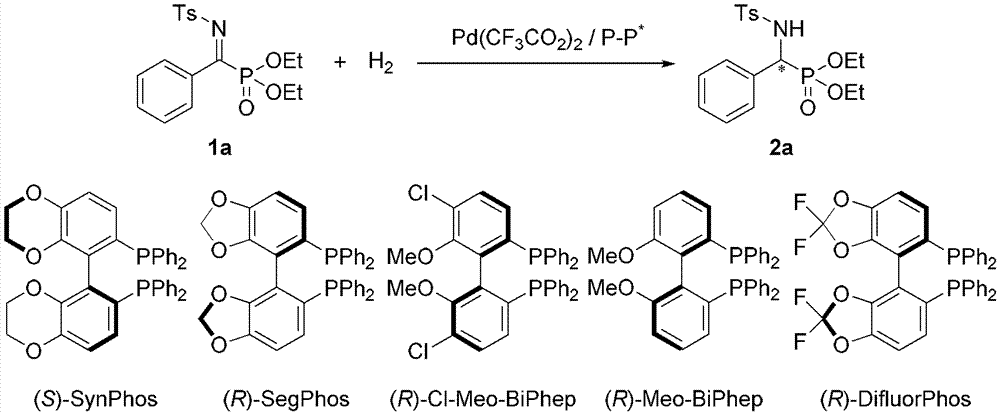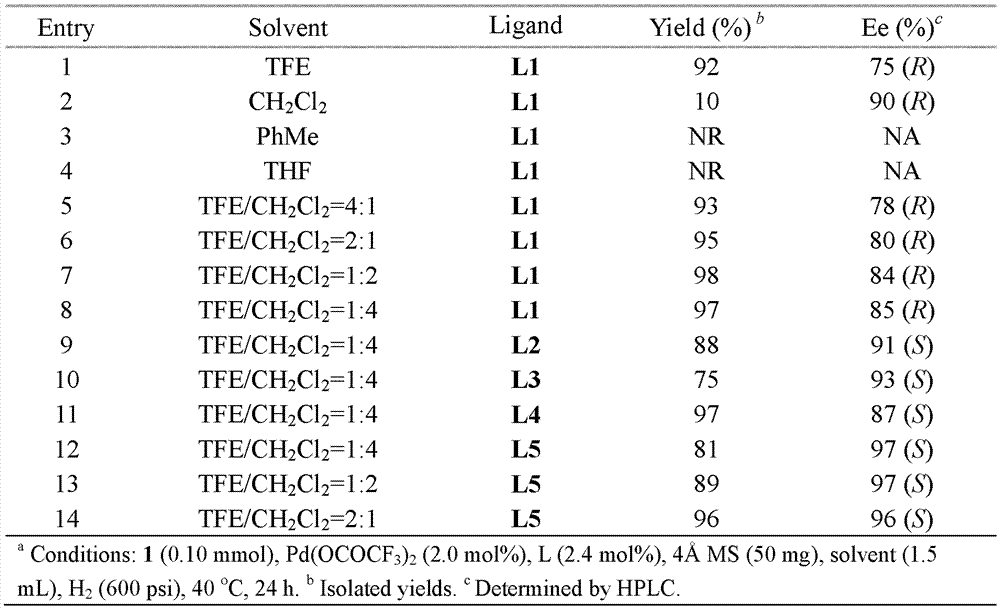Method for synthesizing chiral phosphoramidate by carrying out asymmetric hydrogenation on palladium-catalyzed imine phosphate
A technology for catalyzing imine phosphonate and amino phosphonate, which is applied in the direction of chemical instruments and methods, catalytic reactions, physical/chemical process catalysts, etc., can solve problems such as the inability to synthesize amino phosphonic acid and its derivatives, Achieve the effects of simple and practical reaction operation, high reactivity and enantioselectivity, and chiral value-added
- Summary
- Abstract
- Description
- Claims
- Application Information
AI Technical Summary
Problems solved by technology
Method used
Image
Examples
Embodiment 1
[0031] Embodiment 1: optimization of conditions
[0032] Drop into palladium trifluoroacetate (2mol% of the substrate consumption in formula 1) and chiral phosphine ligand (2.4mol% of the substrate consumption in formula 1) in reaction bottle, add 1mL acetone after nitrogen replacement, room temperature stirs 1- After 3 hours, the catalyst was obtained. Then concentrate in vacuo, add 1.5mL organic solvent under nitrogen, transfer this solution to pre-placed substrate 1a (39.5mg, 0.1mmol) and In a reactor containing molecular sieves (50 mg-100 mg relative to 0.1 mmol of the substrate molecular sieve in Formula 1), 600 psi of hydrogen gas was passed through, and the reaction was carried out at 40° C. for 24 hours. Slowly release hydrogen, remove the solvent and directly separate the pure product by column chromatography. The reaction formula and ligand structure are as follows:
[0033]
[0034] The yield is the separation yield, and the enantiomeric excess of the product ...
Embodiment 2
[0037] Example 2: Synthesis of various chiral aminophosphonates by palladium-catalyzed asymmetric hydrogenation 2
[0038] Drop into palladium trifluoroacetate (2mol% of the substrate consumption in formula 1) and chiral phosphine ligand (2.4mol% of the substrate consumption in formula 1) in reaction bottle, add 1mL acetone after nitrogen displacement, room temperature stirs 1- After 3 hours, the catalyst was obtained. Then concentrate in vacuo, add 1.5mL trifluoroethanol / dichloromethane=volume ratio 2 / 1 mixed solvent under nitrogen, transfer this solution to pre-placed substrate 1 (0.1mmol) and In the reaction kettle of molecular sieve (the amount of molecular sieve is 50mg-100mg relative to 0.1mmol of the substrate molecular sieve in Formula 1), 600psi of hydrogen gas was passed through, and the reaction was carried out at 40°C for 24 hours. Slowly release hydrogen, remove the solvent and directly separate the pure product by column chromatography. The reaction formula and...
Embodiment 3
[0043] Example 3: Synthesis of various chiral aminophosphonates by palladium-catalyzed asymmetric hydrogenation 4
[0044] Drop into palladium trifluoroacetate (2mol% of the substrate consumption in formula 1) and chiral phosphine ligand (2.4mol% of the substrate consumption in formula 1) in reaction bottle, add 1mL acetone after nitrogen displacement, room temperature stirs 1- After 3 hours, the catalyst was obtained. Then concentrate in vacuo, add 1.5mL trifluoroethanol / dichloromethane=volume ratio 2 / 1 mixed solvent under nitrogen, transfer this solution to pre-placed substrate 1 (0.1mmol) and In a reactor containing molecular sieves (50 mg-100 mg relative to 0.1 mmol of the substrate molecular sieve in Formula 1), 600 psi of hydrogen gas was passed through, and the reaction was carried out at 40° C. for 24 hours. Slowly release hydrogen, remove the solvent, and directly separate the pure product by column chromatography. The reaction formula and ligand structure are as fo...
PUM
 Login to View More
Login to View More Abstract
Description
Claims
Application Information
 Login to View More
Login to View More - R&D
- Intellectual Property
- Life Sciences
- Materials
- Tech Scout
- Unparalleled Data Quality
- Higher Quality Content
- 60% Fewer Hallucinations
Browse by: Latest US Patents, China's latest patents, Technical Efficacy Thesaurus, Application Domain, Technology Topic, Popular Technical Reports.
© 2025 PatSnap. All rights reserved.Legal|Privacy policy|Modern Slavery Act Transparency Statement|Sitemap|About US| Contact US: help@patsnap.com



